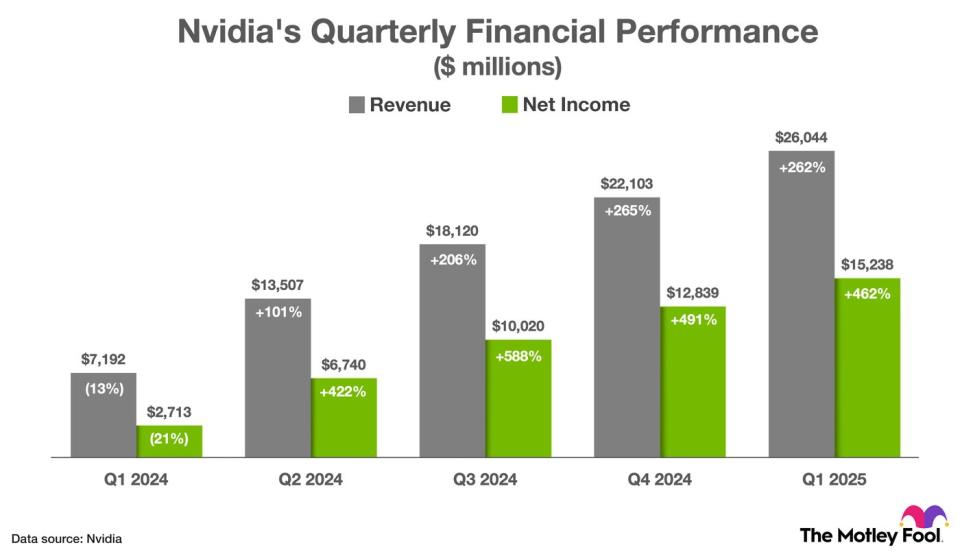Nvidia (NASDAQ: NVDA) will complete a 10-for-1 stock split after market close tomorrow. The split comes on the heels of tremendous price appreciation. Nvidia returned 205% during the past year and 580% during the last three years, with enthusiasm about artificial intelligence being the primary reason for those gains.
What does the split mean for investors? Shareholders will get nine additional shares for each share they own. The stock will begin trading on a split-adjusted basis on Monday, June 10. Importantly, the split will not impact the value of the company, nor will it change an investor’s stake in the company.
The big question is: What happens following the stock split? Of course, there is no way to know for certain, but we can make an educated guess by examining Nvidia’s performance following past stock splits.
History says Nvidia stock is headed for a sharp decline
Nvidia has completed five stock splits since its IPO in 1999. Following those events, shares typically declined (often substantially) during the next 12 months and 24 months, as shown in the chart.
|
Stock Split Date |
Stock Split Type |
Return (12 Months Later) |
Return (24 Months Later) |
|---|---|---|---|
|
July 20, 2021 |
4-for-1 |
(4%) |
145% |
|
Sept. 11, 2007 |
3-for-2 |
(70%) |
(53%) |
|
April 7, 2006 |
2-for-1 |
1% |
(6%) |
|
Sept. 12, 2001 |
2-for-1 |
(72%) |
(49%) |
|
June 27, 2000 |
2-for-1 |
28% |
(52%) |
|
Average |
|
(23%) |
(3%) |
Data source: YCharts.
As shown, Nvidia stock declined by an average of 23% during the 12-month period following past stock splits, and the stock was still down by an average of 3% after 24 months. In other words, history says Nvidia is headed for a steep, prolonged drawdown.
But there is a major asterisk by that statement: Four of the past five stocks splits occurred in close proximity to a recession. Specifically, the U.S. economy was in a recession from March 2001 through November 2001, and from December 2007 through June 2009. Those economic downturns precipitated bear markets that had devastating consequences for the stock market, so Nvidia was naturally dragged down.
Importantly, while shares initially declined, investors have still done exceptionally well if they purchased shares when any of the previous stock splits took place. The chart provides details.
|
Stock Split Date |
Stock Split Type |
Return (Since the Stock Split) |
|---|---|---|
|
July 20, 2021 |
4-for-1 |
527% |
|
Sept. 11, 2007 |
3-for-2 |
14,580% |
|
April 7, 2006 |
2-for-1 |
24,840% |
|
Sept. 12, 2001 |
2-for-1 |
40,100% |
|
June 27, 2000 |
2-for-1 |
42,650% |
Data source: YCharts.
Going forward, Nvidia’s performance depends primarily on its ability to grow revenue and earnings, and investors have good reason to be bullish.
Nvidia is the market leader in artificial intelligence chips
The bull case for Nvidia builds on its critical position in the artificial intelligence (AI) economy. Nvidia graphics processing units (GPUs) are the standard-bearer in accelerated computing, a discipline that pairs specialized hardware and software to speed up demanding data center workloads like AI applications. Indeed, the Wall Street Journal recently reported that “Nvidia’s chips underpin all of the most advanced AI systems, giving the company a market share estimated at more than 80%.”
Dominance in the GPU market has allowed Nvidia to branch into adjacent data center product categories, including central processing units (CPUs) and networking equipment, as well as subscription software and cloud services. CEO Jensen Huang sees that evolution as a key competitive advantage. “We literally build the entire data center,” he told analysts. “This deep intimate knowledge at the entire data center scale is fundamentally what sets us apart today.”
Nvidia has strung together a series of truly impressive financial reports, as shown in the chart. That trend continued in the first quarter. Revenue surged 262% to $26 billion on strong data center sales growth driven by demand for AI products. Meanwhile, gross margin expanded 12 percentage points, and non-GAAP (generally accepted accounting principles) net income jumped 462% to $15.2 billion.

Going forward, Nvidia will inevitably lose momentum at some point, but the company will have a powerful tailwind at its back for years to come. Spending on artificial intelligence hardware, software, and services is projected to increase at 36.6% annually through 2030, according to Grand View Research.
Somewhat surprisingly, Nvidia stock trades at a discount to its historical valuation
Some investors may worry that Nvidia is overvalued, given that shares tripled over the past year. But earnings have actually grown more quickly. Remember, non-GAAP net income increased 462% in the first quarter. That means the price-to-earnings ratio has been falling.
Moreover, Wall Street expects Nvidia to grow earnings per share at 38% annually over the next three to five years, and the stock currently trades at 70 times earnings. That gives a PEG ratio of 1.8, a significant discount to the three-year average of 3.2. In short, Nvidia shares are trading at a cheaper-than-average valuation despite the phenomenal price appreciation of the past year.
I’ll close with a quote from Morgan Stanley analyst Joseph Moore: “Bottom line, we think the backdrop warrants AI exposure even amid extreme enthusiasm — and Nvidia remains the clearest way to get that exposure.”
Should you invest $1,000 in Nvidia right now?
Before you buy stock in Nvidia, consider this:
The Motley Fool Stock Advisor analyst team just identified what they believe are the 10 best stocks for investors to buy now… and Nvidia wasn’t one of them. The 10 stocks that made the cut could produce monster returns in the coming years.
Consider when Nvidia made this list on April 15, 2005… if you invested $1,000 at the time of our recommendation, you’d have $713,416!*
Stock Advisor provides investors with an easy-to-follow blueprint for success, including guidance on building a portfolio, regular updates from analysts, and two new stock picks each month. The Stock Advisor service has more than quadrupled the return of S&P 500 since 2002*.
*Stock Advisor returns as of June 3, 2024
Trevor Jennewine has positions in Nvidia. The Motley Fool has positions in and recommends Nvidia. The Motley Fool has a disclosure policy.
Nvidia Executes Its 10-for-1 Stock Split Tomorrow. History Says the Artificial Intelligence (AI) Stock Will Do This Next (Hint: It May Shock You). was originally published by The Motley Fool

Jessica Roberts is a seasoned business writer who deciphers the intricacies of the corporate world. With a focus on finance and entrepreneurship, she provides readers with valuable insights into market trends, startup innovations, and economic developments.







